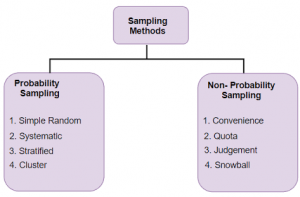Sampling
Measuring a small portion of something and then making a general statement about the whole thing is known as sampling.
- Sampling is a process of selecting a number of units for a study in such a way that the units represent the larger group from which they are selected.
Function
Since it is generally impossible to study an entire population (e.g. many individuals in a country, all college students, every geographic area etc.) researchers typically rely on sampling to acquire a section of the population to perform an experiment or observational study.
It is important that the group selected be representative of the population and not biased in a systematic manner.
For example, a group comprised of wealthiest individuals population in a given area probably would not accurately reflect the opinion of the entire population in that area.
Best safe and secure cloud storage with password protection
Get Envato Elements, Prime Video, Hotstar and Netflix For Free
Best Money Earning Website 100$ Day
#1 Top ranking article submission website
Types of Sampling

A. Probability sampling:
A method of sampling that uses random selection so that all units/cases in the population have an equal probability of being chosen is known as probability or random sampling.
Advantages:
1. Easy to conduct.
2. High probability of achieving a representative sample.
3. Meets assumptions ofmany statistical procedure.
Disadvantages:
1. Identification of all members of the population can be difficult.
2. Contacting all members of the sample can be difficult.
B. Non-probability sampling:
Sampling that does not involve random selection and methods are not based on the10rationale of probability theory is non-probability or non-random sampling.
Simple Random Sampling
Simple random sampling is a probability sampling method.
Definition : A Simple Random Sample (SRS) consists of n individuals from the population chosen such a way that every individual has the equal chance to be selected.
Advantage:
1. Simple to conduct.
2. Each unit has an equal chance of being selected.
Disadvantage :
1. Complete list of individuals in the universe is required.
Systemic (Random) Sampling
There is a gap or interval between each between each selected species of the sample.
Selection of units is based on sample interval k starting from a determined point where k= N/n.
Steps:
1. Number the units on your frame from 1 to N, and the population are arranged in the same way.
2. First sample drawn between 1 and K randomly. (Determine present/ random start.)
3. Afterwards, every k th must be drawn, untill the total sample has been drawn.
Stratified Random Sampling
A stratified random sample is obtained by dividing the Population elements into non-overlapping groups, called strata and then selecting a random sample directly and independently from each stratum.
A stratified SRS is a special case of stratified sampling that uses SRS for selecting units from each stratum.
Cluster Sampling
Cluster Sampling is defined as a sampling technique in which the elements of the population is divided in existing groups (cluster).
Then a sample from the cluster is selected randomly from the population.
sub-types:
- Single stage cluster Sampling.
- Double Stage cluster Samplimg.
- Multiple Stage cluster Sampling.
 Plantlet The Blogging Platform of Department of Botany, University of Dhaka
Plantlet The Blogging Platform of Department of Botany, University of Dhaka





